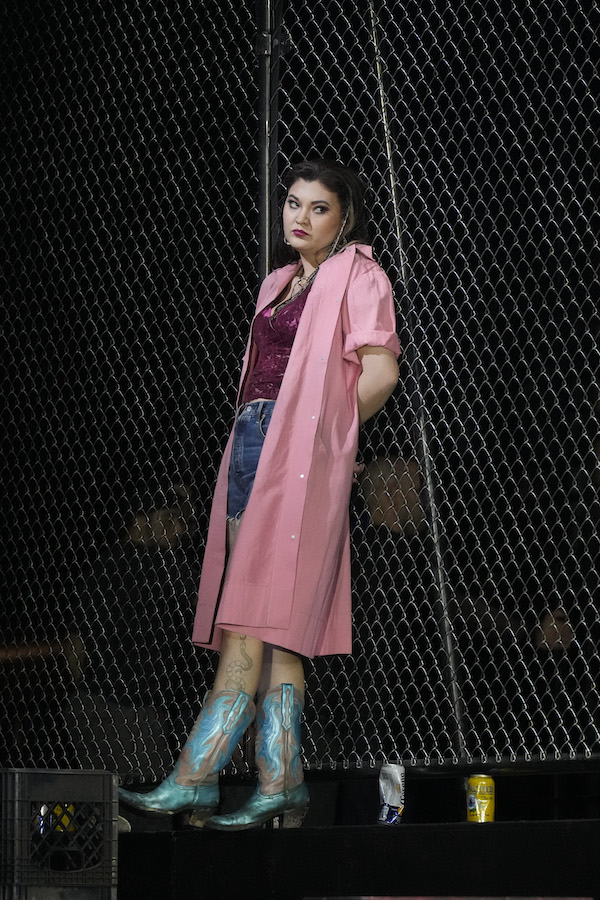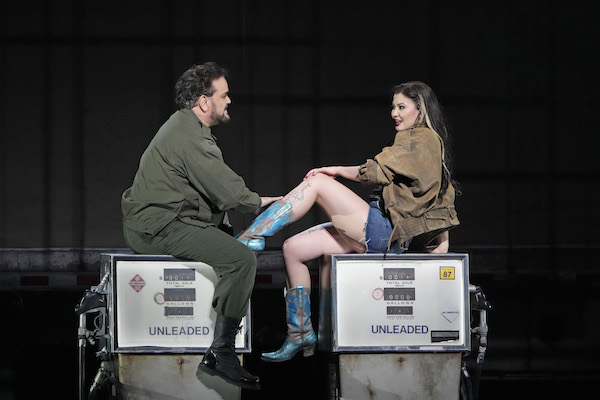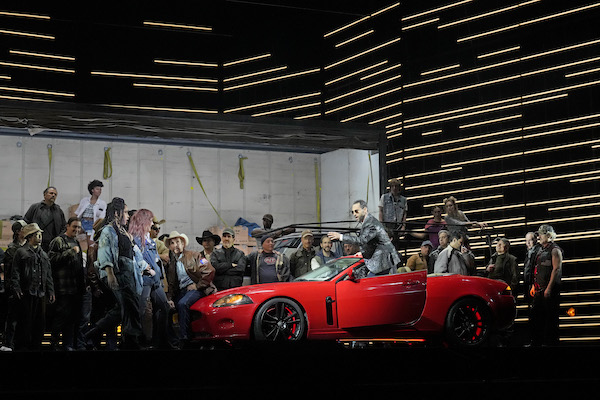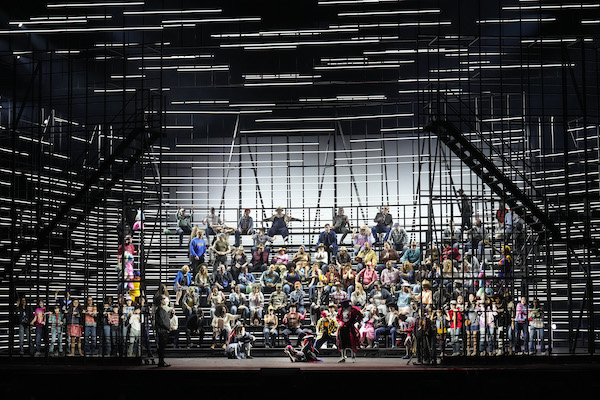Akhmetshina debut propels Met’s retooled rodeo “Carmen”

The Metropolitan Opera rang out 2023 with a sold-out gala performance of Carmen on New Year’s Eve from British theater director Carrie Cracknell—a suitable way to bring down the curtain on a year that saw the Met continue its course to promote contemporary opera and modernized stagings. The changes brought consternation to some and elation to others—as will this exciting new production of Bizet’s enduring favorite.
Carmen is Cracknell’s first production for the Met, although she is no stranger to New York audiences due to her acclaimed production of About Sea Wall / A Life in 2019. Her staging of the two monologues starring Tom Sturridge and Jake Gyllenhaal plumbed the depths of grief through the lens of fatherhood and family in sold-out runs at the Public Theater and on Broadway. The number of theater luminaries in the audience were undoubtedly present on account of her.
Cracknell is hardly the first director to update Carmen. Taking a page from Simon Stone’s 2022 Met updating of Donizetti’s Lucia di Lammermoor, Cracknell transfers the action from sunny Spain to a dystopian rural region of what looks like Southwestern America. Instead of shouts of “Olé!” in the bullring, there are rodeo whoops and hollers. Escamillo is transformed into a bronco-busting star, making his triumphal entrance in a shiny red sports car. Factory workers, soldiers and people living rough on the fringes of society, as well as human nature, don’t change much over time, so little need for updating there, apart from attire.
Upon entering the hall, a red scrim concealed the stage from which abstract, Rothko-like designs gradually emerged. It was the canvas upon which Austrian projection designer Roland Horvath created evocative images that established the mood and atmosphere for each of the opera’s four acts. They generally ended with a gauzy imagine of Carmen with her hand pressed against the scrim, as if she was striving to break the bonds of her existence and perhaps escape the destiny foretold in the cards.
Michael Levine’s sets are grimly realistic, without a touch of the romance of the American Wild West. Women workers enter the factory after running a gauntlet of men who proposition and harass them. Carmen and her friends use a tractor-trailer truck docked in a loading platform as a get-away car with wicked glee and high spirits straight out of Thelma & Louise.
Vehicles are an integral element of Cracknell’s concept in keeping with what she sees as the ethos of rural America. The hijacked truck becomes the main stage element of the following two acts. The women party in its hold with some locals in the second act, while in the next, smugglers unload contraband and firearms from it. There are also vintage pickup trucks and a pair of weathered unleaded gas pumps from a bygone era that add local flavor.

The final act plays out at the rodeo where spectators fill the bleachers and vendors hawk colorful clouds of cotton candy. The crowd is perfectly positioned to project their anticipation over Escamillo’s arrival, as are the kids who cling to the chain-link fence that encases the arena. In the opera’s final moments, Don José bludgeons Carmen to death with one lethal swipe of a baseball bat.
Guy Hoare’s lighting makes the production pop visually just as much as Levine’s sets and Horvath’s projections. The vast expanse of the Met stage is hung with several rows of horizontal, LED-like lighting. Hoare employs them most effectively in Act II, where the pulsating lights and changes of color add a visceral excitement to the action. In the following act, they prove a distraction to the mesmerizing effect of the trashed truck rotating on the stage. In the final act, the soulless white glare captured the conflicting moods—exultant, defiant, or tragic—perfectly.
The Met promised a powerhouse cast for this production and it delivered, even with Rafael Davila stepping in as Don José at the last minute for an indisposed Piotr Beczała.
Much anticipation greeted Aigul Akhmetshina’s Met debut. The Russian mezzo-soprano rose to stardom when she jumped in to sing Carmen at the Royal Opera House London at the age of 21 in 2019. With this prodigiously gifted singer, the Met found the perfect Carmen to ground Cracknell’s production.
Akhmetshina has charisma to burn and a smoldering voice, with earthy, fascinating low notes to match. Attired in turquoise leather cowboy boots and hip-hugging denim shorts—revealing a major thigh tattoo—she exuded more glamor, defiance, and danger than that of the run-of-the-mill factory worker. When she entered the arena on Escamillo’s arm, she was glammed up in fringed leather, but still wearing those boots.
At this stage of her career, Akhmetshina’s lyric mezzo-soprano is full-bodied, rich, and supple, with a presence and clarity that carries effortlessly into the theater. She dug deeply into the depths of Carmen’s psyche, singing a particularly sensuous Habanera and a high-spirited Seguidilla which few men, let alone Davila’s Don José, could resist. Only in the Card Scene did Akhmetshina’s Carmen yield to despair, but with the brazenness and boldness that was always present in her beguiling interpretation of the role.
In contrast, Angel Blue’s Micaëla was styled as a contemporary, decent everywoman. Vocally, however, she poured out lush sound that captured both her love for Don José, as well as a compassion for Carmen not usually found in a Micaëla. Blue’s combination of vocal allure and endearing sincerity in Micaëla’s aria garnered the most heartfelt applause of the evening.
Part and parcel of Cracknell’s concept was to highlight “gender imbalances” and male objectification of women in contemporary society. She achieves that to some degree, although you don’t have to mine too deeply into the opera to find those themes. Placing it in a contemporary context arguably adds greater relevance for some in the audience. Perhaps unwittingly, however, her approach also puts Don José’s psychological profile into sharper focus.
Davila gave a masterful portrayal of Don José’s evolution from a mundane chump of a soldier to an obsessive homicidal maniac. He achieved both through his subtle approach to the role, both dramatically and vocally. The beautiful, somewhat timorous sounds, which he produced in the opening scenes, in no way prepared one for the torrential, tormented outcries of a man spurned in love. Davila’s tenor has an appealing warmth and depth that is present throughout his range. His high notes bloomed effortlessly in the “Flower Song” (“La fleur que tu m’avais jetee”) which he sang with an appealing tenderness. The depths of rage and despair that Davila summoned in his increasingly explosive confrontation with Carmen were jarring. Nothing in Davila’s rather mild, disinterested solder prepared you for the emotional force of the final scene.
Bass-baritone Kyle Ketelsen, attired in black, was glib and dashing as a rodeo-star Escamillo. His voice conveyed sensuality and danger at every turn. In later scenes, the depth of Ketelsen’s characterization impressed when his devil-may-care attitude was equalled by the virility and allure of his voice.
The rest of the cast was equally fine. Bass Wei Wu made his Met debut as Zuniga, displaying a voice as dark and sinister as the character he portrayed. Michael Adams also made an impressive house bow as Dancaïro, one of the smugglers. The baritone had the vocal flare to match his character’s wild, colorful appearance. Benjamin Taylor displayed his customary stalwart demeanor and commanding voice as Moralès.
Sydney Mancasola’s Frasquita and Briana Hunter’s Mercédès were particularly well-etched characterizations as Carmen’s friends. Their sparkling voices made for an especially fleet and delightful quintet in Act II.
In the pit, Daniele Rustioni led a blazing reading of the Prelude, yet his direction was best at revealing the lyricism and emotion of Bizet’s score. The trumpets muffed the opening bugle calls, but otherwise the orchestra performed brilliantly. The solo flute passages in the Act III prelude were so hauntingly beautiful that Rustioni stopped the action to afford the player a solo bow. The Met’s adult and children’s choruses were top notch as always.
When the curtain fell, the crowed roared its approval of the musical forces took their bows. When Davila led Cracknell and her team onstage, there was a slight hush and a smattering of muffled boos.
Carmen continues through May 25 with Clémentine Margaine in the title role, Michael Fabiano as Don José, Ailyn Pérez as Micaëla, and bass-baritone Ryan Speedo Green as Escamillo. metopera.org

